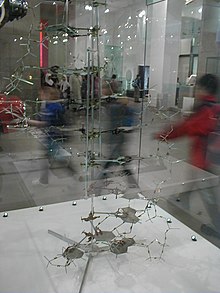Chopstick model
The rod model , also known as the lattice model , is a three-dimensional representation of a molecular structure , the (covalent) atomic bonds of which are represented in rod form. For purely ionic compounds there is the analogous lattice model.
The line model (thin lines), the ball- and -stick model and the dome model are differentiated from this . The ribbon model is available for large proteins .
The illustration can be real or virtual. Really in the form of pinned together plastic or metal tubes or spring elements - there are kits of very different qualities - virtually as a perspective image, e.g. B. at given coordinates with a special image viewer on the monitor can be rotated as desired, or as a stereo image .
Rod models have the advantage that stereochemical aspects of molecules and intramolecular processes of torsion and rotation can be made clear. All atoms are always shown - in contrast to the skeletal formula , where the hydrogen atoms are omitted.
In the rod model, the atomic bonds are usually shown as straight connections between the atomic centers. The bond angles and bond lengths ideally correspond to the scale of the calculated or measured ratios. Multiple bindings are seldom directly identified as such. By not showing the space filling of the atoms, the rod model grants a better deep view into the structure of larger molecules compared to the dome model. A special form of the rod model was the Dreiding stereo model .
The coloring of the atoms is based on the CPK model, as in the space-filling model.
history
The ball-and-stick model was developed in the 19th century by August Wilhelm von Hofmann , who first presented it on April 7, 1865 at an event organized by the London Royal Institution ( Friday Evening Discourse ). To demonstrate, he used croquet balls into which metal sticks were screwed. Hofmann himself initially called this representation glyptic formulæ , roughly "plastic formulas".
In chemical research, the ball-and-stick model was first applied in developing a structure for mesitylene by August Kekulé in 1867. achieved historic importance the stick model in drafting the 1956 James Watson and Francis Crick proposed spatial structure of DNA , the Double helix .
The entire concept of representing chemical structures as a macroscopic model has become an important cornerstone in the visualization of molecular modeling with the help of computer representations.
Web links
Individual evidence
- ^ A b Christoph Meinel: Balls and rods: From the cultural origin of chemical models . In: A look at science . No. 18 , 2006, ISSN 0942-928X , p. 10-18 ( PDF ).
- ↑ James D. Watson, Francis HC Crick: Molecular Structure of Nucleic Acids: A Structure for Deoxyribose Nucleic Acid . In: Nature . tape 171 , no. 4356 , 1953, pp. 737-738 , doi : 10.1038 / 171737a0 .


